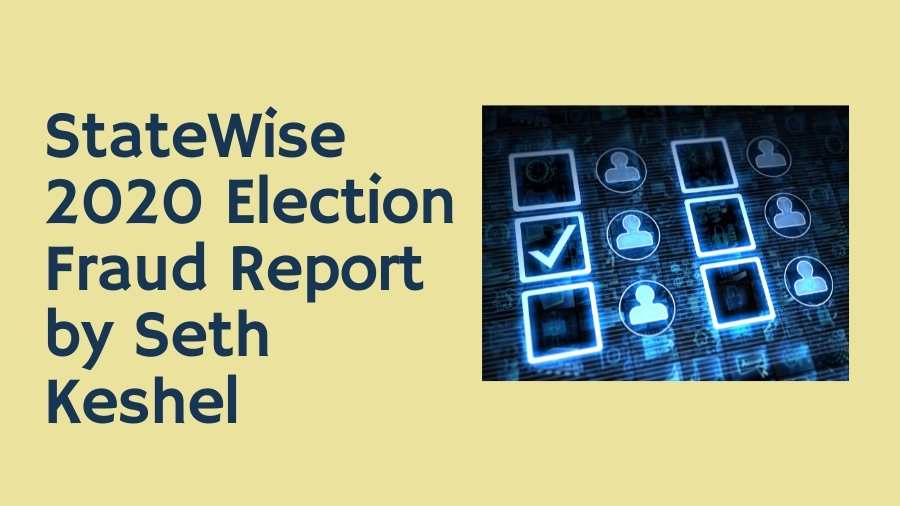Identified on LinkedIn as an executive and former baseball analyst, Seth Keshel does not specify any electoral experience. As noted in his report, the state-by-state tally of Biden’s “excess votes” are “lenient” estimates that require further research, although he frequently repeats the false claim that the numbers suggest fraud.
Seth Keshel analyzed the election results following the November 2020 presidential election based on voter registration levels and actual votes. In several counties, he found alarming irregularities that differed from trend lines that (in many cases) had been reliable for over 100 years. Accordingly, he has published reports for both counties and states that indicate which counties’ votes correspond with voter registration trends and which have small or large deviations from these trends.
Seth Keshel Election Report 2020
| Trump votes | Biden votes | Potential fraud estimate | |||||
|---|---|---|---|---|---|---|---|
| Alabama | 1,441,170 | (62.0%) | 849,624 | (36.6%) | 32,000 | (3.8%) | |
| Alaska | 189,951 | (52.8%) | 153,778 | (42.8%) | 19,000 | (12.4%) | |
| Arizona | 1,661,686 | (49.1%) | 1,672,143 | (49.4%) | 210,000 | (12.6%) | |
| Arkansas | 760,647 | (62.4%) | 423,932 | (34.8%) | 8,000 | (1.9%) | |
| California | 6,006,429 | (34.3%) | 11,110,250 | (63.5%) | 1,346,000 | (12.1%) | |
| Colorado | 1,364,607 | (41.90%) | 1,804,352 | (55.40%) | 183,000 | (10.1%) | |
| Connecticut | 715,291 | (39.2%) | 1,080,680 | (59.2%) | 117,000 | (10.8%) | |
| Delaware | 200,603 | (39.8%) | 296,268 | (58.7%) | 27,000 | (9.1%) | |
| Florida | 5,668,731 | (51.22%) | 5,297,045 | (47.86%) | 296,000 | (5.6%) | |
| Georgia | 2,461,854 | (49.2%) | 2,473,633 | (49.5%) | 299,000 | (12.1%) | |
| Hawaii | 196,864 | (34.3%) | 366,130 | (63.7%) | 55,000 | (15.0%) | |
| Idaho | 554,119 | (63.9%) | 287,021 | (33.1%) | 15,000 | (5.2%) | |
| Illinois | 2,446,891 | (41.3%) | 3,471,915 | (57.5%) | 295,000 | (8.5%) | |
| Indiana | 1,729,519 | (57.0%) | 1,242,416 | (41.0%) | 74,000 | (6.0%) | |
| Iowa | 897,672 | (53.1%) | 759,061 | (44.9%) | 0 | (0.0%) | |
| Kansas | 771,406 | (56.2%) | 570,323 | (41.5%) | 48,000 | (8.4%) | |
| Kentucky | 1,326,646 | (62.1%) | 772,474 | (36.2%) | 62,000 | (8.0%) | |
| Louisiana | 1,255,776 | (58.5%) | 856,034 | (39.9%) | 36,000 | (4.2%) | |
| Maine | 360,737 | (44.0%) | 435,072 | (53.1%) | 31,000 | (7.1%) | |
| Maryland | 976,414 | (32.15%) | 1,985,023 | (65.36%) | 128,000 | (6.4%) | |
| Massachusetts | 1,167,202 | (32.1%) | 2,382,202 | (65.6%) | 235,000 | (9.9%) | |
| Michigan | 2,649,852 | (47.8%) | 2,804,040 | (50.6%) | 527,000 | (18.8%) | |
| Minnesota | 1,484,065 | (45.28%) | 1,717,077 | (52.40%) | 228,000 | (13.3%) | |
| Mississippi | 756,764 | (57.6%) | 539,398 | (41.1%) | 15,000 | (2.8%) | |
| Missouri | 1,718,736 | (56.8%) | 1,253,014 | (41.4%) | 49,000 | (3.9%) | |
| Montana | 343,602 | (56.92%) | 244,786 | (40.55%) | 46,000 | (18.8%) | |
| Nebraska | 556,846 | (58.51%) | 374,583 | (39.36%) | 33,000 | (8.8%) | |
| Nevada | 669,890 | (47.67%) | 703,486 | (50.06%) | 100,000 | (14.2%) | |
| New Hampshire | 365,654 | (45.36%) | 424,921 | (52.71%) | 40,000 | (9.4%) | |
| New Jersey | 1,883,274 | (41.4%) | 2,608,335 | (57.3%) | 327,000 | (12.5%) | |
| New Mexico | 401,894 | (43.5%) | 501,614 | (54.3%) | 84,000 | (16.7%) | |
| New York | 3,251,997 | (37.7%) | 5,244,886 | (60.9%) | 292,000 | (5.6%) | |
| North Carolina | 2,758,775 | (49.93%) | 2,684,292 | (48.59%) | 257,000 | (9.6%) | |
| North Dakota | 235,595 | (65.1%) | 114,902 | (31.8%) | 8,000 | (7.0%) | |
| Ohio | 3,154,834 | (53.27%) | 2,679,165 | (45.24%) | 88,000 | (3.3%) | |
| Oklahoma | 1,020,280 | (65.4%) | 503,890 | (32.3%) | 39,000 | (7.7%) | |
| Oregon | 958,448 | (40.37%) | 1,340,383 | (56.45%) | 162,000 | (12.1%) | |
| Pennsylvania | 3,378,263 | (48.8%) | 3,459,923 | (50.0%) | 504,000 | (14.6%) | |
| Rhode Island | 199,922 | (38.6%) | 307,486 | (59.4%) | 45,000 | (14.6%) | |
| South Carolina | 1,385,103 | (55.1%) | 1,091,541 | (43.4%) | 119,000 | (10.9%) | |
| South Dakota | 261,043 | (61.8%) | 150,471 | (35.6%) | 11,000 | (7.3%) | |
| Tennessee | 1,852,475 | (60.7%) | 1,143,711 | (37.5%) | 101,000 | (8.8%) | |
| Texas | 5,890,347 | (52.1%) | 5,259,126 | (46.5%) | 675,000 | (12.8%) | |
| Utah | 865,140 | (58.13%) | 560,282 | (37.65%) | 131,000 | (23.4%) | |
| Vermont | 112,704 | (30.7%) | 242,820 | (66.1%) | 34,000 | (14.0%) | |
| Virginia | 1,962,430 | (44.0%) | 2,413,568 | (54.1%) | 217,000 | (9.0%) | |
| Washington | 1,584,651 | (38.77%) | 2,369,612 | (57.97%) | 333,000 | (14.1%) | |
| West Virginia | 545,382 | (68.6%) | 235,984 | (29.7%) | 23,000 | (9.7%) | |
| Wisconsin | 1,610,184 | (48.82%) | 1,630,866 | (49.45%) | 139,000 | (8.5%) | |
| Wyoming | 193,559 | (69.9%) | 73,491 | (26.6%) | 1,000 | (1.4%) | |
In the table above are the official vote counts, plus the estimated number of excess Biden votes that could have been cast. This is the number of votes that seem oddly higher than what might have been expected from the trends. Based on population growth and decline, recent historical data on voting and registration, and party registration information, these figures are based on trend analysis in the modern political era.
In an interview with The Hill, Seth explains that he always takes a lenient view of his estimates, and does not consider cyber-attacks that change votes subtly in ways that can go undetected by statistical techniques.
Donald Trump On Seth Keshel’s Investigation and Report
President Donald Trump released a statement thanking Seth Keshel for his work, you can read the statement published in Seth Keshel’s official telegram channel below ( the statement was shared in the telegram channel of Seth Keshel ).

Suggested Article – Electoral fraud expert Seth Keshel releases national fraud figures







4 Comments